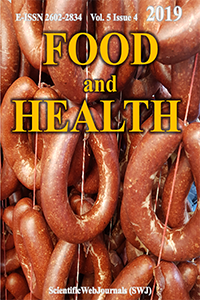EFFECT OF ENCAPSULATED STARTER CULTURE INCLUSION AND HEAT TREATMENT ON BIOGENIC AMINES CONTENT OF SUCUK
Abstract
In this study, the effect of encapsulated starter
culture (Lactobacillus plantarum plus
Staphylococcus xylosus) inclusion on biogenic amines (BAs)
content of sucuk was investigated comparatively in heat treated (at ~70°C for
20 min) and fermented sucuks. The
highest contents of histamine, which is known as the most toxic BA, were
observed in the fermented samples including non-encapsulated (103.6 mg/kg) and
encapsulated (102.3 mg/kg) starter cultures, while the lowest values were
detected in the heat treated sucuks (p
< .05), including non-encapsulated (24.2 mg/kg) and encapsulated (21.4
mg/kg) starter cultures, at the end of 45 days of storage. Based on the
principal component analysis of the microbiological count and BAs content of
the samples, the heat treated and encapsulated starter culture included sucuks
discriminated themselves from control groups and non-encapsulated encapsulated
starter culture included samples with lower histamine and tyramine contents as
well as their microbiological loads.
Supporting Institution
This study was supported by Inonu University, Directorate for Scientific Research
Project Number
2015/36
References
- Ansorena, D., Montel, M., Rokka, M., Talon, R., Eerola, S., Rizzo, A., Demeyer, D. (2002). Analysis of biogenic amines in northern and southern European sausages and role of flora in amine production. Meat Science, 61, 141-147. https://doi.org/10.1016/S0309-1740(01)00174-7
- Bardócz, S. (1995). Polyamines in food and their consequences for food quality and human health. Trends in Food Science and Technology, 6, 341-346. https://doi.org/10.1016/S0924-2244(00)89169-4
- Bilenler, T., Karabulut, I., Candogan, K. (2017). Effects of encapsulated starter cultures on microbial and physicochemical properties of traditionally produced and heat treated sausages (sucuks). LWT -Food Science and Technology, 75, 425-433. https://doi.org/10.1016/j.lwt.2016.09.003
- Bover-Cid, S., Izquierdo-Pulido, M., Vidal-Carou, M.C. (1999). Effect of proteolytic starter cultures of Staphylococcus spp. on biogenic amine formation during the ripening of dry fermented sausages. International Journal of Food Microbiology, 46, 95-104. https://doi.org/10.1016/S0168-1605(98)00170-6
- Bover-Cid, S., Izquierdo-Pulido, M., Vidal-Carou, M.C. (2000). Mixed starter cultures to control biogenic amine production in dry fermented sausages. Journal of Food Protection, 63, 1556-1562. https://doi.org/10.4315/0362-028X-63.11.1556 PMid:11079700
- Bover-Cid, S., Miguélez-Arrizado, M.J., Becker, B., Holzapfel, W.H., Vidal-Carou, M.C. (2008). Amino acid decarboxylation by Lactobacillus curvatus CTC273 affected by the pH and glucose availability. Food Microbiology, 25, 269-277. https://doi.org/10.1016/j.fm.2007.10.013 PMid:18206769
- Bozkurt, H., Erkmen, O. (2002). Effects of starter cultures and additives on the quality of Turkish style sausage (sucuk). Meat Science, 61, 149-156. https://doi.org/10.1016/S0309-1740(01)00176-0
- Bozkurt, H., Erkmen, O. (2004). Effects of temperature, humidity and additives on the formation of biogenic amines in sucuk during ripening and storage periods. Food Science and Technology International, 10, 21-28. https://doi.org/10.1177/1082013204041992
- Corbo, M.R., Bevilacqua, A., Speranza, B., Di Maggio, B., Gallo, M., Sinigaglia, M. (2016). Use of alginate beads as carriers for lactic acid bacteria in a structured system and preliminary validation in a meat product. Meat Science, 111, 198-203. https://doi.org/10.1016/j.meatsci.2015.10.005 PMid:26476507
- Dalmış, Ü., Soyer, A. (2008). Effect of processing methods and starter culture (Staphylococcus xylosus and Pediococcus pentosaceus) on proteolytic changes in Turkish sausages (sucuk) during ripening and storage. Meat Science, 80, 345-354. https://doi.org/10.1016/j.meatsci.2007.12.022 PMid:22063339
- De Prisco, A., Mauriello, G. (2016). Probiotication of foods: A focus on microencapsulation tool. Trends in Food Science and Technology, 48, 27-39. https://doi.org/10.1016/j.tifs.2015.11.009
- Eerola, S., Hinkkanen, R., Lindfors, E., Hirvi, T. (1993). Liquid chromatographic determination of biogenic amines in dry sausages. Journal of AOAC International, 76, 575-577.
- Ercoşkun, H., Tağı, Ş., Ertaş, A.H. (2010). The effect of different fermentation intervals on the quality characteristics of heat-treated and traditional sucuks. Meat Science, 85, 174-181. https://doi.org/10.1016/j.meatsci.2009.12.022 PMid:20374882
- Galgano, F., Favati, F., Bonadio, M., Lorusso, V., Romano, P. (2009). Role of biogenic amines as index of freshness in beef meat packed with different biopolymeric materials. Food Research International, 42, 1147-1152. https://doi.org/10.1016/j.foodres.2009.05.012
- Gardini, F., Özogul, Y., Suzzi, G., Tabanelli, G., Özogul, F. (2016). Technological factors affecting biogenic amine content in foods: a review. Frontiers in Microbiology, 7, 1218. https://doi.org/10.3389/fmicb.2016.01218 PMid:27570519 PMCid:PMC4982241
- Gençcelep, H., Kaban, G., Kaya, M. (2007). Effects of starter cultures and nitrite levels on formation of biogenic amines in sucuk. Meat Science, 77, 424-430. https://doi.org/10.1016/j.meatsci.2007.04.018 PMid:22061796
- Gençcelep, H., Kaban, G., Aksu, M.İ., Öz, F., Kaya, M. (2008). Determination of biogenic amines in sucuk. Food Control, 19, 868-872. https://doi.org/10.1016/j.foodcont.2007.08.013
- Hernández-Jover, T., Izquierdo-Pulido, M., Veciana-Nogués, M. T., Mariné-Font, A., Vidal-Carou, M. C. (1997). Biogenic amine and polyamine contents in meat and meat products. Journal of Agricultural and Food Chemistry, 45, 2098-2102. https://doi.org/10.1021/jf960790p
- Jairath, G., Singh, P. K., Dabur, R. S., Rani, M., Chaudhari, M. (2015). Biogenic amines in meat and meat products and its public health significance: a review. Journal of Food Science and Technology, 52, 6835-6846. https://doi.org/10.1007/s13197-015-1860-x
- Kaban, G., Kaya, M. (2009). Effects of Lactobacillus plantarum and Staphylococcus xylosus on the quality characteristics of dry fermented sausage "Sucuk". Journal of Food Science, 74, 58-63. https://doi.org/10.1111/j.1750-3841.2008.01014.x PMid:19200122
- Kailasapathy, K. (2002). Microencapsulation of probiotic bacteria: technology and potential applications. Current Issues in Intestinal Microbiology, 3, 39-48.
- Kaniou, I., Samouris, G., Mouratidou, T., Eleftheriadou, A., Zantopoulos, N. (2001). Determination of biogenic amines in fresh unpacked and vacuum-packed beef during storage at 4°C. Food Chemistry, 74, 515-519. https://doi.org/10.1016/S0308-8146(01)00172-8
- Kurt, Ş., Zorba, Ö. (2009). The effects of ripening period, nitrite level and heat treatment on biogenic amine formation of "sucuk" - a Turkish dry fermented sausage. Meat Science, 82, 179-184. https://doi.org/10.1016/j.meatsci.2009.01.008 PMid:20416765
- Kurt, Ş., Zorba, Ö. (2010). Biogenic amine formation in Turkish dry fermented sausage (sucuk) as affected by nisin and nitrite. Journal of the Science of Food and Agriculture, 90, 2669-2674. https://doi.org/10.1002/jsfa.4138 PMid:20740550
- Latorre-Moratalla, M.L., Bover-Cid, S., Talon, R., Garriga, M., Zanardi, E., Ianieri, A., Vidal-Carou, M.C. (2010). Strategies to reduce biogenic amine accumulation in traditional sausage manufacturing. LWT-Food Science and Technology, 43, 20-25. https://doi.org/10.1016/j.lwt.2009.06.018
- Leroy, F., Verluyten, J., De Vuyst, L. (2006). Functional meat starter cultures for improved sausage fermentation. International Journal of Food Microbiology, 106, 270-285. https://doi.org/10.1016/j.ijfoodmicro.2005.06.027 PMid:16213053
- Martín, M.J., Lara-Villoslada, F., Ruiz, M.A., Morales, M.E. (2015). Microencapsulation of bacteria: a review of different technologies and their impact on the probiotic effects. Innovative Food Science and Emerging Technologies, 27, 15-25. https://doi.org/10.1016/j.ifset.2014.09.010
- Papavergou, E.J. (2011). Biogenic amine levels in dry fermented sausages produced and sold in Greece. Procedia Food Science, 1, 1126-1131. https://doi.org/10.1016/j.profoo.2011.09.168
- Rabie, M.A., Peres, C., Malcata, F.X. (2014). Evolution of amino acids and biogenic amines throughout storage in sausages made of horse, beef and turkey meats. Meat Science, 96, 82-87. https://doi.org/10.1016/j.meatsci.2013.05.042 PMid:23896140
- Ravyts, F., Vuyst, L. De, Leroy, F. (2012). Bacterial diversity and functionalities in food fermentations. Engineering in Life Sciences, 12, 356-367. https://doi.org/10.1002/elsc.201100119
- Ruiz-Capillas, C., Jiménez-Colmenero, F. (2004). Biogenic amines in meat and meat products. Critical Reviews in Food Science and Nutrition, 44, 489-499. https://doi.org/10.1080/10408690490489341
- Ruiz-Capillas, C., Jiménez Colmenero, F., Carrascosa, A.V., Muñoz, R. (2007). Biogenic amine production in Spanish dry-cured "chorizo" sausage treated with high-pressure and kept in chilled storage. Meat Science, 77, 365-371. https://doi.org/10.1016/j.meatsci.2007.03.027 PMid:22061789
- Santos, M.H.S. (1998). Amino acid decarboxylase capability of microorganizms isolated in Spain fermented meat product. International Journal of Food Microbiology, 29, 227-230. https://doi.org/10.1016/S0168-1605(97)00129-3
- Scientific Opinion on risk based control of biogenic amine formation in fermented foods (2011). EFSA Journal, 9, 2393. https://doi.org/10.2903/j.efsa.2011.2393
- Soyer, A., Ertaş, A.H., Üzümcüoğlu, Ü. (2005). Effect of processing conditions on the quality of naturally fermented Turkish sausages (sucuks). Meat Science, 69, 135-141. https://doi.org/10.1016/j.meatsci.2004.06.015 PMid:22062649
- Sultana, K., Godward, G., Reynolds, N., Arumugaswamy, R., Peiris, P., Kailasapathy, K. (2000). Encapsulation of probiotic bacteria with alginate-starch and evaluation of survival in simulated gastrointestinal conditions and in yoghurt. International Journal of Food Microbiology, 62, 47-55. https://doi.org/10.1016/S0168-1605(00)00380-9
- Sun, X., Zhou, K., Gong, Y., Zhang, N., Yang, M., Qing, D., Yang, Y. (2016). Determination of biogenic amines in Sichuan-style spontaneously fermented sausages. Food Analytical Methods, 9, 2299-2307. https://doi.org/10.1007/s12161-016-0417-6
- Suzzi, G., Gardini, F. (2003). Biogenic amines in dry fermented sausages: a review. International Journal of Food Microbiology, 88, 41-54. https://doi.org/10.1016/S0168-1605(03)00080-1
- Tabanelli, G., Coloretti, F., Chiavari, C., Grazia, L., Lanciotti, R., Gardini, F. (2012). Effects of starter cultures and fermentation climate on the properties of two types of typical Italian dry fermented sausages produced under industrial conditions. Food Control, 26, 416-426. https://doi.org/10.1016/j.foodcont.2012.01.049
Abstract
Project Number
2015/36
References
- Ansorena, D., Montel, M., Rokka, M., Talon, R., Eerola, S., Rizzo, A., Demeyer, D. (2002). Analysis of biogenic amines in northern and southern European sausages and role of flora in amine production. Meat Science, 61, 141-147. https://doi.org/10.1016/S0309-1740(01)00174-7
- Bardócz, S. (1995). Polyamines in food and their consequences for food quality and human health. Trends in Food Science and Technology, 6, 341-346. https://doi.org/10.1016/S0924-2244(00)89169-4
- Bilenler, T., Karabulut, I., Candogan, K. (2017). Effects of encapsulated starter cultures on microbial and physicochemical properties of traditionally produced and heat treated sausages (sucuks). LWT -Food Science and Technology, 75, 425-433. https://doi.org/10.1016/j.lwt.2016.09.003
- Bover-Cid, S., Izquierdo-Pulido, M., Vidal-Carou, M.C. (1999). Effect of proteolytic starter cultures of Staphylococcus spp. on biogenic amine formation during the ripening of dry fermented sausages. International Journal of Food Microbiology, 46, 95-104. https://doi.org/10.1016/S0168-1605(98)00170-6
- Bover-Cid, S., Izquierdo-Pulido, M., Vidal-Carou, M.C. (2000). Mixed starter cultures to control biogenic amine production in dry fermented sausages. Journal of Food Protection, 63, 1556-1562. https://doi.org/10.4315/0362-028X-63.11.1556 PMid:11079700
- Bover-Cid, S., Miguélez-Arrizado, M.J., Becker, B., Holzapfel, W.H., Vidal-Carou, M.C. (2008). Amino acid decarboxylation by Lactobacillus curvatus CTC273 affected by the pH and glucose availability. Food Microbiology, 25, 269-277. https://doi.org/10.1016/j.fm.2007.10.013 PMid:18206769
- Bozkurt, H., Erkmen, O. (2002). Effects of starter cultures and additives on the quality of Turkish style sausage (sucuk). Meat Science, 61, 149-156. https://doi.org/10.1016/S0309-1740(01)00176-0
- Bozkurt, H., Erkmen, O. (2004). Effects of temperature, humidity and additives on the formation of biogenic amines in sucuk during ripening and storage periods. Food Science and Technology International, 10, 21-28. https://doi.org/10.1177/1082013204041992
- Corbo, M.R., Bevilacqua, A., Speranza, B., Di Maggio, B., Gallo, M., Sinigaglia, M. (2016). Use of alginate beads as carriers for lactic acid bacteria in a structured system and preliminary validation in a meat product. Meat Science, 111, 198-203. https://doi.org/10.1016/j.meatsci.2015.10.005 PMid:26476507
- Dalmış, Ü., Soyer, A. (2008). Effect of processing methods and starter culture (Staphylococcus xylosus and Pediococcus pentosaceus) on proteolytic changes in Turkish sausages (sucuk) during ripening and storage. Meat Science, 80, 345-354. https://doi.org/10.1016/j.meatsci.2007.12.022 PMid:22063339
- De Prisco, A., Mauriello, G. (2016). Probiotication of foods: A focus on microencapsulation tool. Trends in Food Science and Technology, 48, 27-39. https://doi.org/10.1016/j.tifs.2015.11.009
- Eerola, S., Hinkkanen, R., Lindfors, E., Hirvi, T. (1993). Liquid chromatographic determination of biogenic amines in dry sausages. Journal of AOAC International, 76, 575-577.
- Ercoşkun, H., Tağı, Ş., Ertaş, A.H. (2010). The effect of different fermentation intervals on the quality characteristics of heat-treated and traditional sucuks. Meat Science, 85, 174-181. https://doi.org/10.1016/j.meatsci.2009.12.022 PMid:20374882
- Galgano, F., Favati, F., Bonadio, M., Lorusso, V., Romano, P. (2009). Role of biogenic amines as index of freshness in beef meat packed with different biopolymeric materials. Food Research International, 42, 1147-1152. https://doi.org/10.1016/j.foodres.2009.05.012
- Gardini, F., Özogul, Y., Suzzi, G., Tabanelli, G., Özogul, F. (2016). Technological factors affecting biogenic amine content in foods: a review. Frontiers in Microbiology, 7, 1218. https://doi.org/10.3389/fmicb.2016.01218 PMid:27570519 PMCid:PMC4982241
- Gençcelep, H., Kaban, G., Kaya, M. (2007). Effects of starter cultures and nitrite levels on formation of biogenic amines in sucuk. Meat Science, 77, 424-430. https://doi.org/10.1016/j.meatsci.2007.04.018 PMid:22061796
- Gençcelep, H., Kaban, G., Aksu, M.İ., Öz, F., Kaya, M. (2008). Determination of biogenic amines in sucuk. Food Control, 19, 868-872. https://doi.org/10.1016/j.foodcont.2007.08.013
- Hernández-Jover, T., Izquierdo-Pulido, M., Veciana-Nogués, M. T., Mariné-Font, A., Vidal-Carou, M. C. (1997). Biogenic amine and polyamine contents in meat and meat products. Journal of Agricultural and Food Chemistry, 45, 2098-2102. https://doi.org/10.1021/jf960790p
- Jairath, G., Singh, P. K., Dabur, R. S., Rani, M., Chaudhari, M. (2015). Biogenic amines in meat and meat products and its public health significance: a review. Journal of Food Science and Technology, 52, 6835-6846. https://doi.org/10.1007/s13197-015-1860-x
- Kaban, G., Kaya, M. (2009). Effects of Lactobacillus plantarum and Staphylococcus xylosus on the quality characteristics of dry fermented sausage "Sucuk". Journal of Food Science, 74, 58-63. https://doi.org/10.1111/j.1750-3841.2008.01014.x PMid:19200122
- Kailasapathy, K. (2002). Microencapsulation of probiotic bacteria: technology and potential applications. Current Issues in Intestinal Microbiology, 3, 39-48.
- Kaniou, I., Samouris, G., Mouratidou, T., Eleftheriadou, A., Zantopoulos, N. (2001). Determination of biogenic amines in fresh unpacked and vacuum-packed beef during storage at 4°C. Food Chemistry, 74, 515-519. https://doi.org/10.1016/S0308-8146(01)00172-8
- Kurt, Ş., Zorba, Ö. (2009). The effects of ripening period, nitrite level and heat treatment on biogenic amine formation of "sucuk" - a Turkish dry fermented sausage. Meat Science, 82, 179-184. https://doi.org/10.1016/j.meatsci.2009.01.008 PMid:20416765
- Kurt, Ş., Zorba, Ö. (2010). Biogenic amine formation in Turkish dry fermented sausage (sucuk) as affected by nisin and nitrite. Journal of the Science of Food and Agriculture, 90, 2669-2674. https://doi.org/10.1002/jsfa.4138 PMid:20740550
- Latorre-Moratalla, M.L., Bover-Cid, S., Talon, R., Garriga, M., Zanardi, E., Ianieri, A., Vidal-Carou, M.C. (2010). Strategies to reduce biogenic amine accumulation in traditional sausage manufacturing. LWT-Food Science and Technology, 43, 20-25. https://doi.org/10.1016/j.lwt.2009.06.018
- Leroy, F., Verluyten, J., De Vuyst, L. (2006). Functional meat starter cultures for improved sausage fermentation. International Journal of Food Microbiology, 106, 270-285. https://doi.org/10.1016/j.ijfoodmicro.2005.06.027 PMid:16213053
- Martín, M.J., Lara-Villoslada, F., Ruiz, M.A., Morales, M.E. (2015). Microencapsulation of bacteria: a review of different technologies and their impact on the probiotic effects. Innovative Food Science and Emerging Technologies, 27, 15-25. https://doi.org/10.1016/j.ifset.2014.09.010
- Papavergou, E.J. (2011). Biogenic amine levels in dry fermented sausages produced and sold in Greece. Procedia Food Science, 1, 1126-1131. https://doi.org/10.1016/j.profoo.2011.09.168
- Rabie, M.A., Peres, C., Malcata, F.X. (2014). Evolution of amino acids and biogenic amines throughout storage in sausages made of horse, beef and turkey meats. Meat Science, 96, 82-87. https://doi.org/10.1016/j.meatsci.2013.05.042 PMid:23896140
- Ravyts, F., Vuyst, L. De, Leroy, F. (2012). Bacterial diversity and functionalities in food fermentations. Engineering in Life Sciences, 12, 356-367. https://doi.org/10.1002/elsc.201100119
- Ruiz-Capillas, C., Jiménez-Colmenero, F. (2004). Biogenic amines in meat and meat products. Critical Reviews in Food Science and Nutrition, 44, 489-499. https://doi.org/10.1080/10408690490489341
- Ruiz-Capillas, C., Jiménez Colmenero, F., Carrascosa, A.V., Muñoz, R. (2007). Biogenic amine production in Spanish dry-cured "chorizo" sausage treated with high-pressure and kept in chilled storage. Meat Science, 77, 365-371. https://doi.org/10.1016/j.meatsci.2007.03.027 PMid:22061789
- Santos, M.H.S. (1998). Amino acid decarboxylase capability of microorganizms isolated in Spain fermented meat product. International Journal of Food Microbiology, 29, 227-230. https://doi.org/10.1016/S0168-1605(97)00129-3
- Scientific Opinion on risk based control of biogenic amine formation in fermented foods (2011). EFSA Journal, 9, 2393. https://doi.org/10.2903/j.efsa.2011.2393
- Soyer, A., Ertaş, A.H., Üzümcüoğlu, Ü. (2005). Effect of processing conditions on the quality of naturally fermented Turkish sausages (sucuks). Meat Science, 69, 135-141. https://doi.org/10.1016/j.meatsci.2004.06.015 PMid:22062649
- Sultana, K., Godward, G., Reynolds, N., Arumugaswamy, R., Peiris, P., Kailasapathy, K. (2000). Encapsulation of probiotic bacteria with alginate-starch and evaluation of survival in simulated gastrointestinal conditions and in yoghurt. International Journal of Food Microbiology, 62, 47-55. https://doi.org/10.1016/S0168-1605(00)00380-9
- Sun, X., Zhou, K., Gong, Y., Zhang, N., Yang, M., Qing, D., Yang, Y. (2016). Determination of biogenic amines in Sichuan-style spontaneously fermented sausages. Food Analytical Methods, 9, 2299-2307. https://doi.org/10.1007/s12161-016-0417-6
- Suzzi, G., Gardini, F. (2003). Biogenic amines in dry fermented sausages: a review. International Journal of Food Microbiology, 88, 41-54. https://doi.org/10.1016/S0168-1605(03)00080-1
- Tabanelli, G., Coloretti, F., Chiavari, C., Grazia, L., Lanciotti, R., Gardini, F. (2012). Effects of starter cultures and fermentation climate on the properties of two types of typical Italian dry fermented sausages produced under industrial conditions. Food Control, 26, 416-426. https://doi.org/10.1016/j.foodcont.2012.01.049
Details
| Primary Language | English |
|---|---|
| Subjects | Food Engineering |
| Journal Section | Research Articles |
| Authors | |
| Project Number | 2015/36 |
| Publication Date | October 1, 2019 |
| Submission Date | January 30, 2019 |
| Published in Issue | Year 2019Volume: 5 Issue: 4 |
Journal is licensed under a
CreativeCommons Attribtion-ShareAlike 4.0 International Licence 


Diamond Open Access refers to a scholarly publication model in which journals and platforms do not charge fees to either authors or readers.
Open Access Statement:
This is an open access journal which means that all content is freely available without charge to the user or his/her institution. Users are allowed to read, download, copy, distribute, print, search, or link to the full texts of the articles, or use them for any other lawful purpose, without asking prior permission from the publisher or the author. This is in accordance with the BOAI definition of open access.
Archiving Policy:
Archiving is done according to ULAKBİM "DergiPark" publication policy (LOCKSS).


